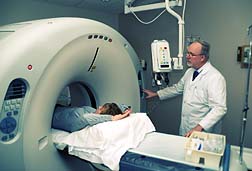 The required warning also advises to avoid the use of GBCA's (Contrast agents containing Gadolinium) unless the diagnostic information is essential and not available with non-contrast enhanced magnetic resonance imaging (MRI).
The required warning also advises to avoid the use of GBCA's (Contrast agents containing Gadolinium) unless the diagnostic information is essential and not available with non-contrast enhanced magnetic resonance imaging (MRI).But is the jury still out on gadolinium and its association with Nephrogenic systemic fibrosis (NSF), a systemic fibrosing disorder first recognized in 1997? Not according to Renal and Urology News. In September, 2009 it reported that the medical community has great concern about "prevention of this currently untreatable disease…it is our duty as physicians, and we are working to protect patients from a process that is associated with such morbidity and increased mortality."
"Prevention should be aggressively pursued by identifying high-risk patients and avoiding GBCA exposure if possible," said. Dr. Perazella, Associate Professor of Medicine and Director of the Nephrology Fellowship Program at Yale University School of Medicine, New Haven, CT. " In those patients whose risk/benefit ratio favors GBCA imaging, the lowest dose of a macrocyclic agent should be utilized."
However, the Mayo Clinic study (American Journal of Roentgenology, October 2009) showed that contrast agents are harmless—more or less--but the study is misleading, according to attorney Debra DeCarli. The study cataloged the effects of 456,930 injections of iodinated and gadolinium contrast agents, used in MRI and CT scans, over a four-year period from 2002-2006 and reported only about one in 1,000 injections was associated with an adverse reaction, the most common being hives, accounting for over half of all reported side effects. BUT, " this conclusion masks the fact that occurrences of NSF were not counted as part of the study," said DeCarli.
"The overwhelming majority of adverse effects were mild, represented with nausea and vomiting and mild rash. Only 16 cases necessitated transfer for further observation and treatment," said Christopher H. Hung, MD, lead author of the study."Contrast agents are very safe to use and they are often essential in aiding the diagnosis of CT and MR studies. As our study suggests, with the advent of newer contrast agents we have been able to improve their power-ability and safety profile."
DeCarli pointed out that, while the study reports 158,439 doses of gadolinium contrast agents between 2002 and 2006, there were only 64 "cases of adverse effects" for gadolinium. "But the devil is in the details, in this case the study's definition of 'adverse effect'," she said. "Adverse effect was defined as a reaction occurring in the radiology suite during contrast administration or within 30 minutes of administration."
Back to the Mayo Study."While contrast reactions can occur, it is important to note that they are rarely severe. Most of the reactions we saw in our study were mild and did not require treatment other than observation and supportive care," Hunt added.
Unfortunately, reactions have been very severe for some people who were injected with gadolinium prior to receiving an MRI--and side effects showed up later.
READ MORE MRI HEALTH RISK LEGAL NEWS
Since my husband had these MRIs, he has had complete kidney failure, congestive heart failure, viral pneumonia and needs oxygen. He has to use a catheter: for the past month he hasn't been able to urinate and the skin on his arms and legs is dark and leathery, but it tears and bleeds with the least little scrape. Now we found out that NSF is a man-made disease; you can imagine how furious I am."
